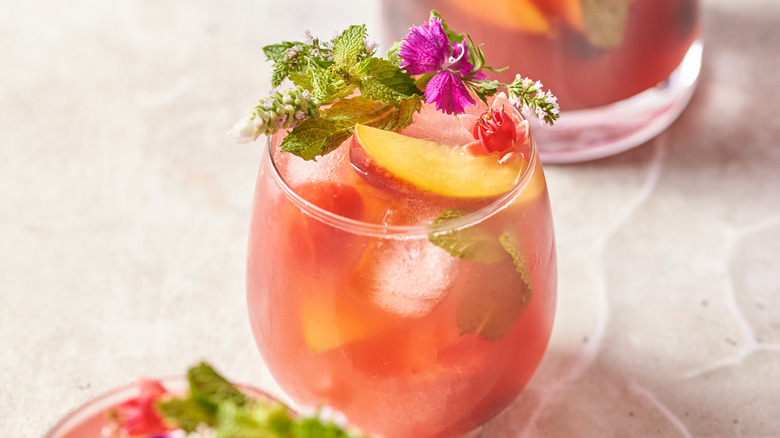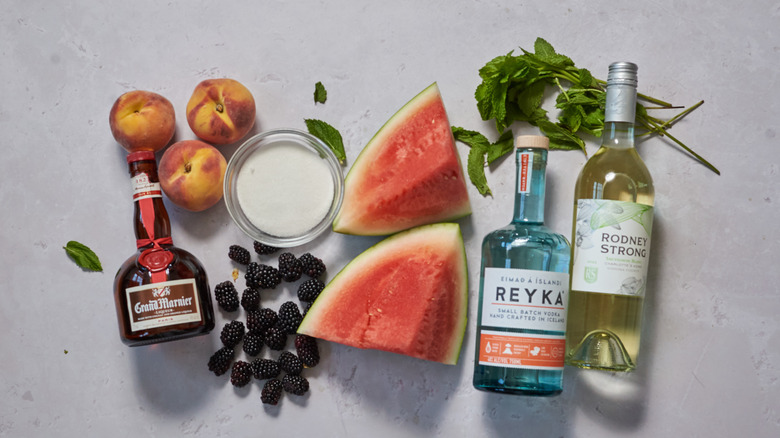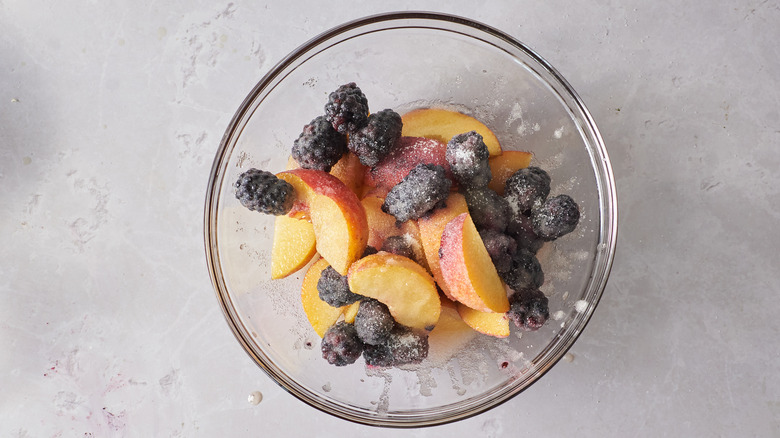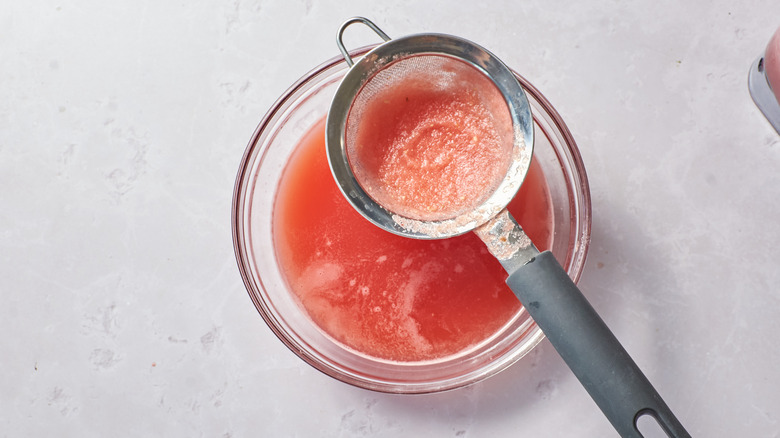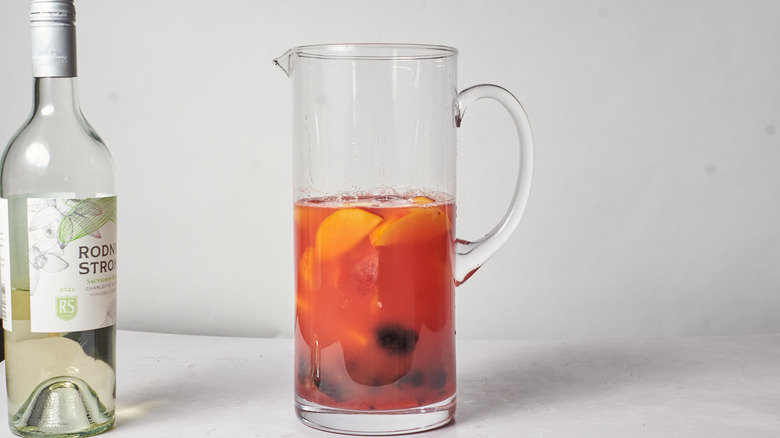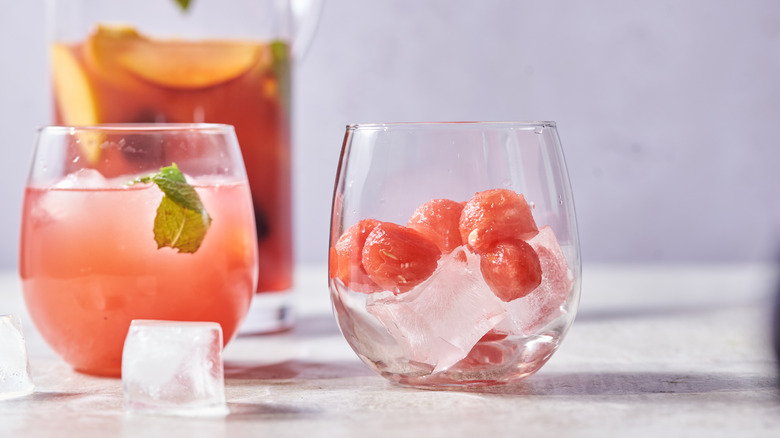Summery Watermelon Sangria Recipe
When thinking of sangria, it's typical to think of the traditional Spanish sangria made with red wine and citrus. While this is still a popular sangria year-round, modern sangrias have welcomed a variety of seasonal wines and produce; summery rosés are filled with strawberry and lime, and autumnal whites are brimming with fresh apples and cinnamon. Sangria is meant to complement the time of year it's served, to be enjoyed as a refreshing (and boozy) ode to the season.
We could go on and on about the joys of sangria; between wine, sugar, and fruit, there isn't much to complain about. In this recipe developed with Michelle McGlinn, crisp white wine is mixed with fresh watermelon juice and poured on top of lightly macerated summer fruits. The result is a sweet, crisp, and faintly citrusy sangria, perfect for the hottest days of the year. And after draining the pitcher, we highly recommend digging out some forks to feast on the wine-soaked fruits; think of it as the best fruit salad you'll ever have.
Gathering the ingredients for summery watermelon sangria
To make the jammy sugared fruits, you'll need sugar, Grand Marnier, blackberries, and peaches. Grand Marnier is recommended specifically because it has the richness of cognac, the sweetness of sugar, and the slight taste of citrus. However, you can swap it with any cognac, orange liqueur, or brandy. The fruits can be swapped, too, if you're in a bind; nectarines, plums, red grapes or raspberries will also work well here.
For the liquid of the sangria, you'll need about ½ of a small watermelon, sauvignon blanc, and vodka. The fruits will make this sangria plenty sweet, but for an even sweeter version, swap the dry wine for rosé or pinot grigio. To serve, grab some fresh mint and a few more scoops of watermelon (and maybe some fresh flowers, to make it pretty).
Macerating fruit
This sneaky technique is the perfect way to infuse a sangria with sugary sweetness. Macerating is a little like marinating, typically involving sweet foods and liquids. The goal is to soften, sweeten, and extract juices from the fruits, infusing them with additional flavor or sugar. Technically, fruit releases liquid simply by sitting in sugar, but adding a liquid helps develop the flavor and jammy texture a little more.
To do this, add the blackberries and peaches to a large bowl or pitcher (whichever one allows all fruit to be covered in sugar), then add the Grand Marnier and sugar. Stir so that all the fruit is coated, then let it rest for as long as a few hours — since the fruit will steep in the sangria anyway, macerating for just 30 minutes will do the trick here.
Blend and strain the watermelon
Because watermelon is mostly (you guessed it) water, blending it for a few seconds produces a thin and pulpy juice. While straining the juice is technically optional, it will help give the sangria a smooth and silky texture free of seeds. To strain, use a fine strainer and pour the juice through, scraping the sides to allow the liquid to pass through the pulp. Once you have 1 ½ cups strained, discard the pulp (and drink the extra, if desired).
Combine everything into a pitcher
Now the easy part: dump the wine, watermelon juice, and vodka into a pitcher on top of the fruits. By now, the fruit will have released some liquid from marinating in the sugar — be sure to mix that into the sangria for added sweetness. Let the sangria steep for several hours in the refrigerator. If you're short on time and need to serve the sangria immediately, give it a few good stirs and serve it with ice.
Serving and storing sangria
Sangria stores well for about 3 to 4 days in the refrigerator. In fact, the flavor will intensify overnight, making this sangria even better the next day. After 3 or 4 days, the fruit will start to break down, so watch for old and mushy fruits and discard them as needed.
To serve, use a melon baller to scoop balls of watermelon from the other half of the melon. Drop them into glasses with ice, then pour the sangria over top. Garnish with plenty of mint on top, and if desired, sprinkle with edible flowers for an extra-summery vibe. Pro tip: serve the melon balls on cocktail picks that can be used to snack on the fruit after finishing.
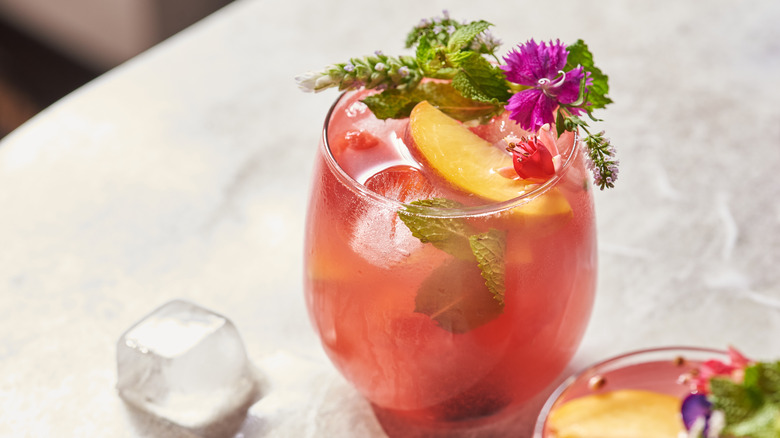
- 2 cups blackberries
- 3 cups sliced peaches
- ½ cup sugar
- ¼ cup Grand Marnier
- 1 medium watermelon, divided (half for 1 1/2 cups juice, half for serving)
- ¼ cup vodka
- 2 cups sauvignon blanc
- Mint, for serving
- Edible flowers
- In a small bowl or large pitcher, combine the blackberries, peaches, sugar, and Grand Marnier, stirring to coat the fruit as much as possible. Let rest for 30 minutes; fruit will release some liquid as they macerate.
- Blend 3 cups of watermelon into a liquid. Strain the watermelon juice in a fine mesh strainer to remove seeds and pulp.
- Place fruit and their liquid in a pitcher and cover with 1 ½ cups watermelon juice. Add the vodka and sauvignon blanc and stir. If desired, let rest for 1 hour to let the flavors develop.
- To serve, scoop remaining watermelon half into balls with a melon baller and add them to glasses. Add ice, then pour sangria over ice. Garnish with mint and the sangria's fruit, along with edible flowers, if desired.
| Calories per Serving | 502 |
| Total Fat | 1.5 g |
| Saturated Fat | 0.1 g |
| Trans Fat | 0.0 g |
| Cholesterol | 0.0 mg |
| Total Carbohydrates | 88.2 g |
| Dietary Fiber | 7.9 g |
| Total Sugars | 73.3 g |
| Sodium | 7.1 mg |
| Protein | 5.6 g |
